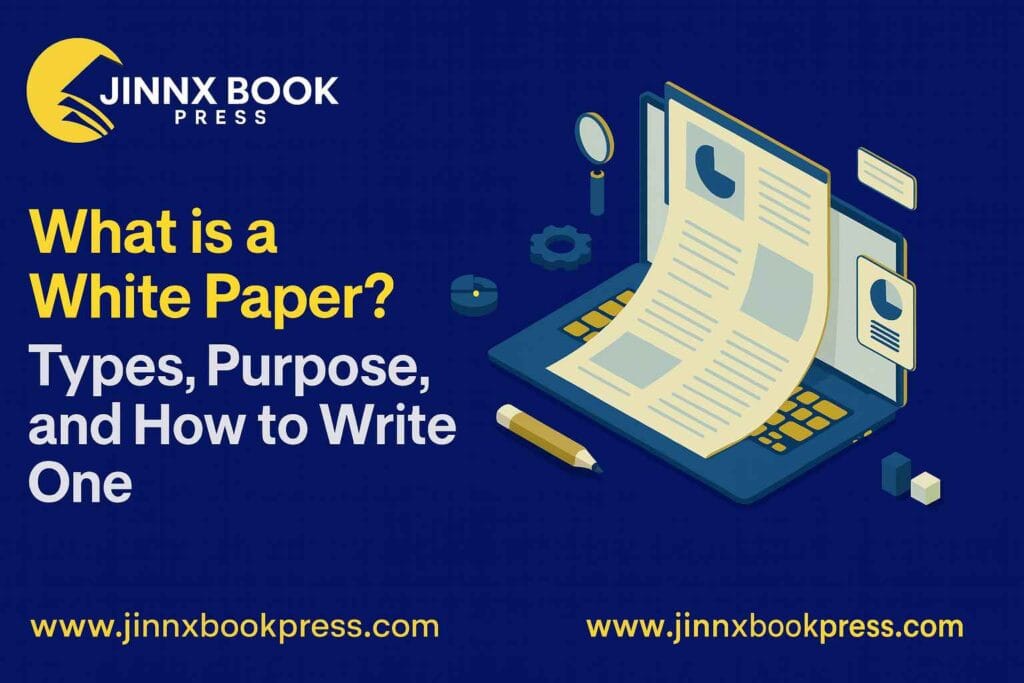Understanding what a white paper is can significantly boost your content marketing and thought leadership strategy. A white paper is a professional document designed to explain complex subjects, propose solutions, and guide readers through informed decision-making. In the world of business and B2B marketing, white papers serve as detailed, research-backed reports that demonstrate expertise, build credibility, and influence buyers.
Key Takeaways – What Is a White Paper?
- A white paper is a formal, detailed guide explaining complex topics in an easy-to-understand format.
- White papers help readers understand an issue, explore solutions, and evaluate expert viewpoints.
- They are serious documents based on research and not casual blog posts or promotional content.
- There are three main types of white papers: Backgrounder, Problem/Solution, and Numbered List.
- Learning how to write a white paper involves choosing a topic, researching, outlining, writing clearly, and revising for clarity.
What Is a White Paper? Full Explanation
So, what is a white paper in business terms? A white paper is a long-form, data-driven document that explores an issue in detail, offers a clear perspective, and suggests actionable solutions. It’s not a sales pitch—it’s an educational resource designed to help readers make informed decisions.
Definition of a white paper: A white paper is a formal report that explains technical, complex, or niche topics in a structured and informative way.
Why Understanding What a White Paper Is Matters
Let’s say you’re launching a new product or service. Instead of pushing a promotional flyer, you create a comprehensive document that explains how the product solves a problem, what features it includes, and why it’s different from the competition. That’s exactly what a white paper does—it informs, educates, and persuades using logic and research, not hype.
Characteristics of a White Paper
To fully understand what is a white paper, consider its core characteristics:
- Educational in nature: Focused on informing, not selling.
- Formal and authoritative: Backed by research, expert opinions, and credible sources.
- Persuasive: White papers gently nudge readers toward a decision without being overtly promotional.
- Strategic: Businesses use white papers to demonstrate expertise, support sales processes, and engage stakeholders.
Types of White Papers
There are three primary types of white papers, each suited for different content goals and audience needs:
1. Backgrounder White Paper
A backgrounder white paper provides technical details, specifications, and in-depth product information. It’s ideal for introducing new products or technologies.
2. Problem/Solution White Paper
This type identifies a specific issue and presents one or more solutions. A problem/solution white paper is commonly used in B2B marketing to highlight how a product or service resolves a pain point.
3. Numbered List White Paper
The numbered list white paper format breaks information into digestible chunks. Examples include “10 Benefits of Cloud Hosting” or “5 Ways to Improve Cybersecurity.”
Why Use Different Types of White Papers?
When you understand what is a white paper and its different formats, you can tailor your message to suit:
- Different reader needs: Some readers want deep technical insights (Backgrounder), others want a solution (Problem/Solution), and many prefer quick takeaways (Numbered List).
- Different scenarios: Launching a product, solving a known problem, or building engagement—all require a different white paper format.
What Is the Purpose of a White Paper?
If you’re wondering what is the purpose of a white paper, it comes down to these key objectives:
Educate Readers
White papers simplify complex topics like blockchain, cloud computing, or cybersecurity—making them easier to understand.
Offer Solutions
They help solve business problems by highlighting strategies, products, or innovations that can address key challenges.
Build Authority
By publishing well-researched, insightful white papers, companies position themselves as industry leaders.
Guide Decision-Making
White papers help readers compare options, understand pros and cons, and choose the right solution.
Start Conversations
White papers spark thought-provoking discussions, generate engagement, and support ongoing education in your niche.
Who Should Read a White Paper?
Anyone asking “what is a white paper?” is likely a decision-maker, researcher, or business professional seeking detailed insights before committing to a product, policy, or service. They include:
- Industry professionals
- Business executives
- Policy makers
- Investors and analysts
- Academics
How to Write a White Paper
If you’re ready to go from “what is a white paper” to “how to write a white paper,” follow these essential steps:
Step 1: Choose a Relevant Topic
Pick a topic that solves a real problem or offers unique value to your readers.
Step 2: Conduct Thorough Research
Collect data, insights, expert opinions, and case studies to support your content.
Step 3: Understand Your Audience
Tailor your white paper to your readers’ knowledge level, interests, and needs.
Step 4: Create a Strong Outline
Structure your white paper logically, with an introduction, main sections, and a conclusion.
Step 5: Write with Clarity
Use simple, clear language. Avoid jargon unless it’s necessary—and always define technical terms.
Step 6: Present Your Solution or Insight
Clearly show how your findings, service, or strategy helps resolve the issue.
Step 7: Edit and Revise
Review your white paper for accuracy, grammar, and flow. A polished white paper builds more trust.
Step 8: Format Professionally
Use headings, bullet points, visuals (charts/graphs), and consistent design to increase readability.
Step 9: Publish and Distribute
Post your white paper on your website, blog, newsletter, or industry portals. Make it easy for the right audience to find it.
Conclusion: What Is a White Paper and Why It Matters
In summary, understanding what a white paper is can help you better communicate complex ideas, demonstrate thought leadership, and provide real value to your audience. Whether you’re crafting a backgrounder on a new product, solving a client’s problem, or compiling a list of practical tips—white papers give you a powerful format to inform, influence, and inspire.


